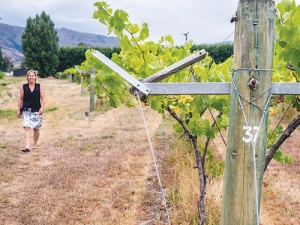Well they are all inventions that in one way or another were overlooked for products that would become universally adopted, but not necessarily because they were better.
It might be a drawing a low bow to suggest that the Geneva Double Curtain (GDC) grape trellising system has anything in common with the format war between VHS and Betamax, but for a system that has the potential to give higher yields on smaller plots of land, offer greater protection from frost and save labour, isn't it strange that only one vineyard in the Alexandra basin has it installed?
Actually, the Alexandra Wine Company is one of only two vineyards in the whole country training their vines this way. For owner Shona Garry it seemed like a no-brainer when together with her husband David, they devloped their vineyard back in 1993. Back then, there were hardly any grapes grown in their immediate vicinity so figuring out what worked and what didn't was a matter of trial and error.
"In 1994 we planted our first vines in the home block, and at that stage there weren't too many vineyards around. There was Black Ridge, William Hill and Alan Brady in Gibbston plus a wee tier of smaller vineyards," says Shona.
"I did a viticulture course and we considered all the different trellising systems. We actually consulted Richard Smart's book, Sunlight into Wine and we based all of our trellising on his dimensions to start with, and then modified and improved each block as we went."
The most interesting thing to notice when approaching the vines at the Davishon Vineyard is the horizontally divided canopy on each row. By taking a dense canopy and training the vines into bilateral cordons so that the shoots grow downward, the idea behind the GDC set-up is to increase overall exposure to sunlight yet minimise canopy density.
"That was one of the reasons we opted for GDC, but we also liked the idea that it is a high wire system and we are slightly frost prone, one degree per meter is what they used to say back then. The fact that everything is chest height so no bending makes it a lot easier for pickers, but our ultimate goal was still to make quality wine."
It's well recognised that in order to improve the yield and quality of vitis vinifera, the most widely adopted trellising systems are all designed to control a vine's natural impulse to head straight up towards the light. Even still, it must have seemed slightly cavalier to deviate away from the more commonly adopted VSP set-up, and opt for a process where the shoots are allowed to grow downward, hanging like two curtains. If nothing else, it certainly created a different approach to vineyard management.
"As the natural tendency is for the vine to grow upwards, every January we go and bring the vines down. When the cordons were young they used to rotate, so instead of clipping wires up like everyone else, we simply pull a wire over and clip it down. Now the cordons have got massive and won't rotate anymore. We just lay it down in the centre and open it up so the bunches are all sitting there with just the right amount of leaf plucking. Some people said that it would have been best to replace the cordons at this stage and lay down another cane, but it seemed criminal to take off all those cordons. So just laying them down the way we do, works just fine and they are naturally long enough and heavy enough that they want to lay down anyway."
In the two decades since they first planted grapes on land that is just a stones throw from the 1860s winery of Jean Desire Feraud, the same sense of pioneer spirit and invention lives on.
From altering the position of the wires onto the top of the T shape, slightly widening the rows and modifying a spray unit to get down into the centre of the rows, the Garry's have had ample time to understand how their vineyard works and what they need to manipulate and when. Managing most of the viticulture themselves to minimise cost, Shona thinks that overall, the GDC is an easier system to work with
"We don't have to lift wires continually and tuck, we simply pull down once and that is it. Normally there is not a huge amount of leaf plucking either, but when it comes to weed control with all the vines climbing down towards the ground, you have to time the weed sprays well so that you don't have to do too many."
The one area of viticulture that Shona and David don't handle themselves is the winter pruning, which is contracted out. What is normally a straightforward process for the pruners can be anything but at The Alexandra Wine Company.
"We want downward spurs which tends to throw them a bit. So now they normally book us as the first vineyard to prune, as we are different. Once we are out of the way, they can then switch back to upward spurs. We don't know why, but any upright shoots from the cordon never ripen as well as the downward, so we always try to take them out."
Sunlight is a crucial element in grape growing, but should exposing clusters to the harsh Central Otago sun, as the GDC is designed to do, be approached with caution? It's not like you can slip, slop, slap with the precious Pinot Noir.
"This was something we never realised at the start, but sunburn is a factor. The berries at the top of each bunch get a little brown dot on the skin but it doesn't seem to affect the flavour at all, it just prevents the berry from completely growing. We think it might have something to do with water on the berries and the concentrated light on a bubble of water, so we are careful with when we put the sprays on."
In a 2011 article written on the GDC by Cameron Douglas MS, he concludes that a one size fits all approach to selecting a vine trellising system might be doing your location, climate, soil profile and grape variety a disservice. For the Alexandra Wine Company, they are unsure if the difference in trellising is the reason for their success or not
"We have been successful so it's obviously working, but then we'll never know what the wine off this land would be like on another trellis system," says Shona. "Is it the system, is it the block, is it the vines? We'll never know. We seem to get veraison much earlier than other people and have to get our nets on early, but we still pick at approximately the same time. Does it do something to our flavour profile, we're not sure? We have been able to achieve consistent quality with it and looking back would we change anything if we did it all again? I really don't know. I think it would be nice to have another block planted here in a VSP system to give us a sense of comparison."










